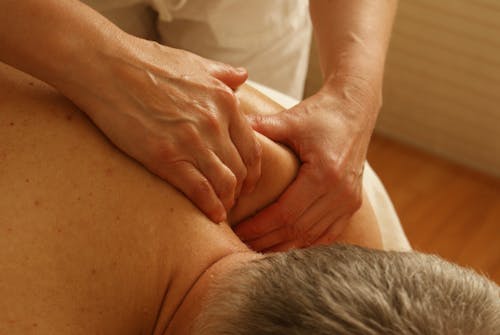
Back and neck pain are two of the most common types of chronic pain. According to the World Health Organization, 568 million people worldwide suffer from back pain, and it is one of the leading causes of disability in 160 countries. This is followed by neck pain, with almost 289 million people complaining of this issue. If you are suffering from both back and neck pain, take comfort in knowing that you are not alone because they are very prevalent problems in the modern world due to our lifestyle and poor posture. Today, many people constantly hunch their backs, tense their shoulders, strain their necks and slouch while looking at their phones or computers.
Furthermore, it is vital to note that back and neck pain has a broad range of intensity. The kind of pain you feel may be different from the back and neck pain of someone you know. This is because back and neck pain can be mild, dull, and annoying on the milder end. Or, it can be severely debilitating, sharp, and disabling on the more intense side. Pain in both areas can interfere with normal daily functioning, and adversely impact your quality of life.
On top of that, the type of pain you feel can be acute or chronic. Acute pain means it comes suddenly and intensely but doesn’t last for long. When it’s chronic pain, the pain can persistently last for weeks, months, or years. In this scenario, the discomfort you feel may be intermittent or non-stop. No matter what kind of pain you feel, know that you don’t have to suffer in silence, and there are pain management programs that could work for you. It is therefore imperative to consult your doctor if you have persistent pain that won’t go away.
In this article, we will discuss the causes of back and neck pain. Finding out the root of the pain can help you mitigate risk factors and avoid the pain’s onset. Remember, your back matters because it keeps your spine aligned and supports your whole upper body, including your head. Meanwhile, your neck allows you to move your head in its full range of motion.
If you live with back and neck pain, it can result in irritability, poor posture, difficulty breathing, and impaired mobility. Find out the leading causes of back and neck pain below.

What Causes Back and Neck Pain?
In general, your back is meant to be sturdy, and your neck should be flexible. However, the neck is especially susceptible to injuries because of its unique range of motion. Your head is very heavy, and when you look downwards while looking at your phone or computer, you’re putting up to 40 pounds of pressure on your neck. Below are some causes of back and neck pain:
Improper Posture
In today’s digital world, many people rarely keep an upright posture. This is because of the frequent smartphone, TV, gaming, and other gadget use. “Text neck” has become a modern disease exacerbated by lower back pain because people are generally hunched over their devices. As a result, this can trigger muscle spasms, resulting in pain in your back and neck. Other reasons for these strains are:
- Improper posture while reading in bed
- Teeth grinding
- Lifting an object the wrong way
- Sudden jerking of the neck
Injuries
When you face injuries, it can result in neck and back pain. For example, rear-end automobile accidents often result in a whiplash injury which can cause chronic neck pain.
Whiplash injuries happen when your head jerks backward then forward due to the force. This can strain the soft tissues of your neck and damage your back as well. Other accidents that can result in neck and back pain include the following:
- Falling down the stairs
- Tripping and landing on the ground in an awkward position
- Sports-related injuries due to abrupt twisting of both neck and back
- Improper use such as the incorrect heavy lifting of weights or repetitive wrong movement
Stress
Many people tense their shoulders and other muscles when they’re stressed, which can lead to back and neck pain. Tense, tight, and sore muscles are known to be one of the physical symptoms of stress. When you de-stress through meditation or other self-regulating activities, you’ll notice your muscles start to relax, which can help relieve your back and neck pain.
Worn Out Parts
Unfortunately, your neck is one of those joints that tend to wear down with age. The same goes for your spine, which is why it is common to see the elderly with spine curvature. Also, according to studies, one of the certainties in life that all human beings share is sarcopenia. This condition is when your muscle mass changes as you age.
Sadly, muscles are known to shrink, and they are eventually replaced by fibrous tissue or fats, which further weaken the muscles. In addition, bones can degenerate with aging or due to certain risk factors like osteoporosis or bone brittleness. Finally, without proper support, everything becomes too difficult to bear, resulting in pain.

Nerve Compression
Risk factors such as osteoarthritis cause the cartilage, which serves as the cushions between your vertebrae or spine bones, to deteriorate. This results in bone spurs, which can eventually affect your mobility in both the neck and spine. In addition, these bone spurs and herniated discs in the vertebrae of your spine and neck can end up pressing on the nerve-ending in the area, resulting in pain and discomfort.
Obesity
Unfortunately, being overweight or obese puts you at higher risk for back and neck pain. The reason for this is the extra weight places increased pressure on your vertebrae and discs. In addition, most overweight people have poor muscle tone, so few ligaments support the spinal column. Consequently, this part wears down quickly, resulting in muscle strain and discomfort.
Diseases
Sadly, certain diseases can put you at risk for back and neck pain. So if you have debilitating pain that won’t go away, see your doctor get cleared of these possible health conditions:
- Rheumatoid arthritis
- Infection like meningitis
- Abnormal growth pinching nerves or cancerous tumors
- Aortic aneurysm
Smoking
Studies show that smokers are more prone to neck and back pain. If you still haven’t kicked your nicotine habit to the curb, you may want to completely snuff out cigarette smoking from your life because it can damage the cervical discs in your neck and back. These discs located between the vertebrae act as a shock absorber to protect the spine. The more you smoke, the more dehydrated they become and the more they shrink. The degeneration can lead to pain and make you more prone to injuries from regular movement and accidents.

How is Back and Neck Pain Diagnosed and Treated?
If you experience pain in your neck and back, your doctor will ask you to go for a complete physical exam. X-rays, CT scans, or an MRI may be ordered to get a full picture of your back and neck’s soft tissues, ligament, blood vessels, and tendons. Blood work may also be conducted to determine if you have arthritis or an infection.
X-rays can also reveal if you have scoliosis, which is an abnormal curvature of the spine that often results in back and neck pain.
Typically, if you have back and neck discomfort, you can treat it with daily stretches and OTC medications such as ibuprofen or acetaminophen to manage the pain. Rest and move gently during this period to not exacerbate the condition. Warm compresses also work to soothe the painful areas. Your doctor may also prescribe anti-inflammatories to alleviate any swelling. In some cases, neck braces and corsets are given for more support. However, surgery and rehabilitation are the only answers to manage pain and restore normal functioning for severe cases.
Can Back and Neck Pain be Prevented?
You can prevent neck and back pain unrelated to disease and congenital conditions. The most important thing you can do is be mindful of your posture when using your phone, computers, and other gadgets. Being mindful of your posture helps you put less strain on your muscles. Strive to have proper spinal alignment when sleeping, standing, walking, or sitting.
Moreover, practice the proper lifting techniques to avoid injuries. If an object looks too heavy, always ask for help. And if you pick up something from the ground, bend your legs and squat instead of just bending from your waist. Most of all, exercise to improve your balance, strengthen your muscles, and maintain a healthy weight.
If you have a family history of osteoarthritis and osteoporosis, make sure you get enough calcium and vitamin D in your diet to promote strong bones. If you’re curious about your genetic risk factors for arthritis or osteoporosis, you can find out by reviewing your health report from CircleDNA.







Comments are closed.